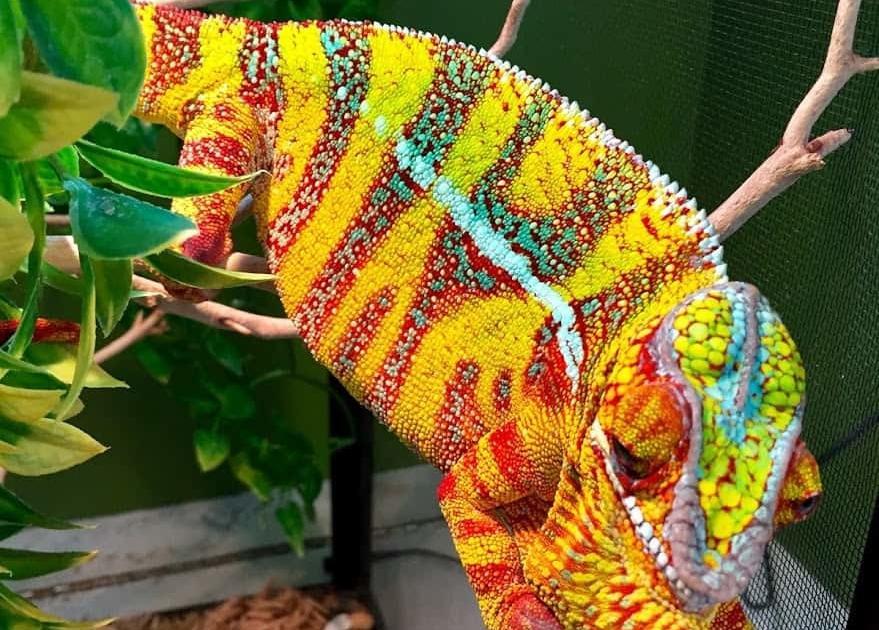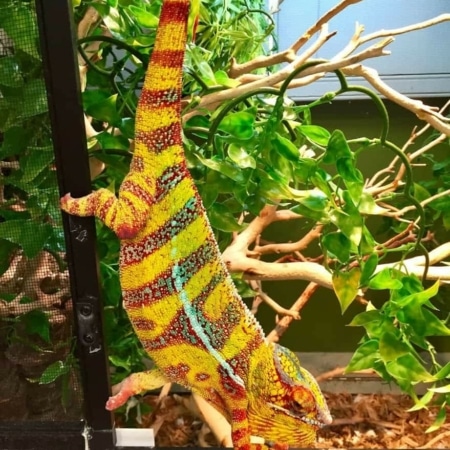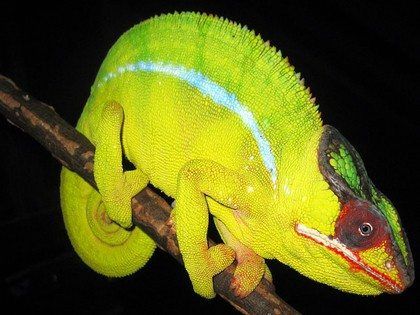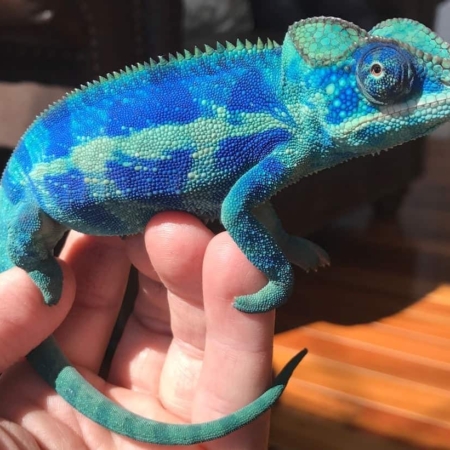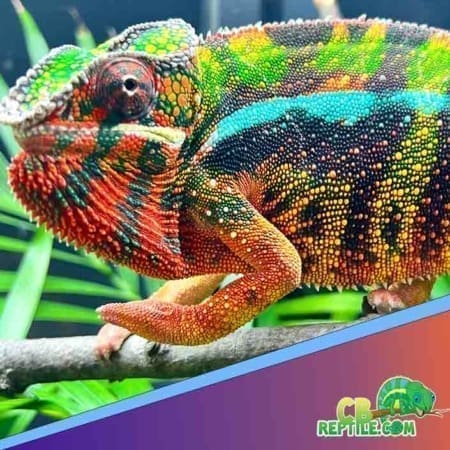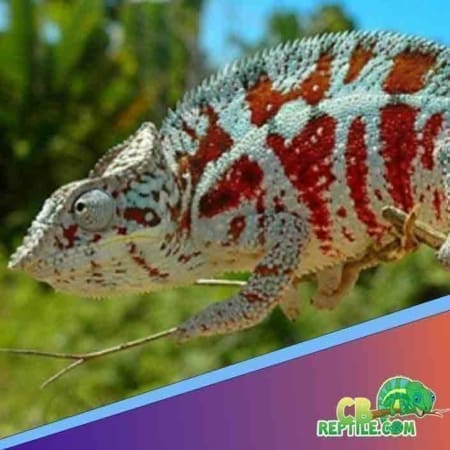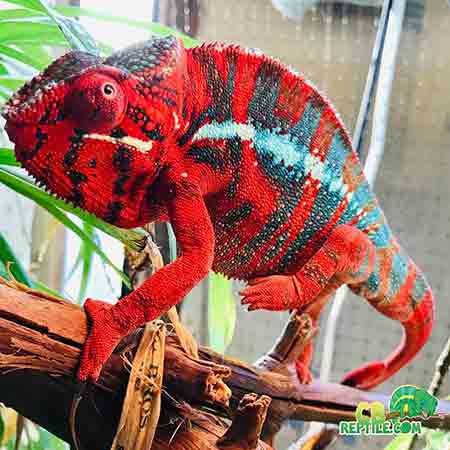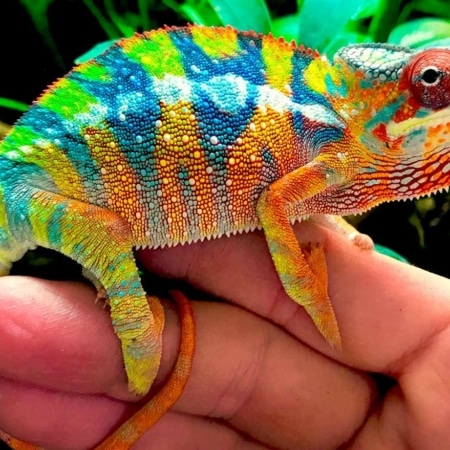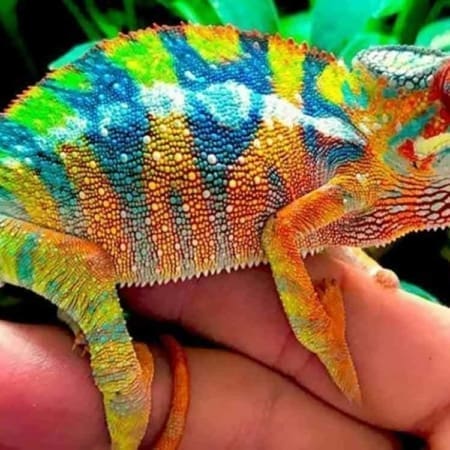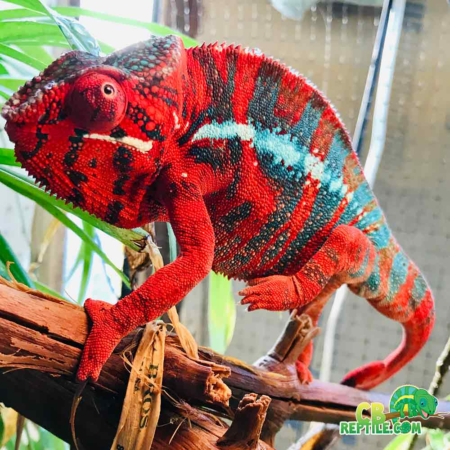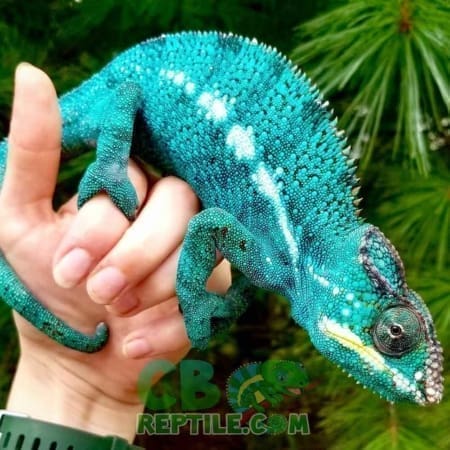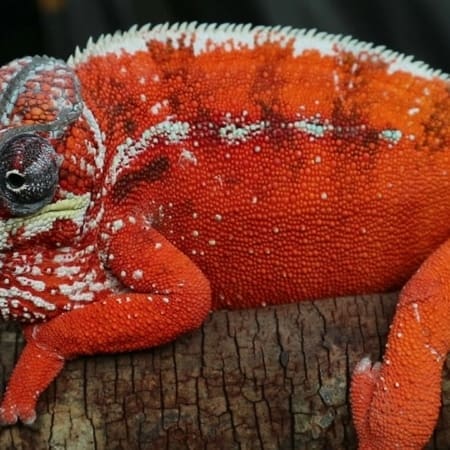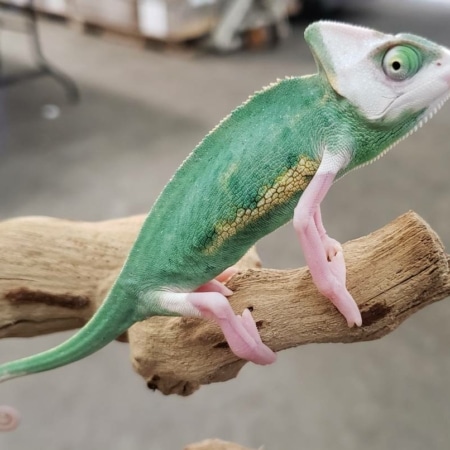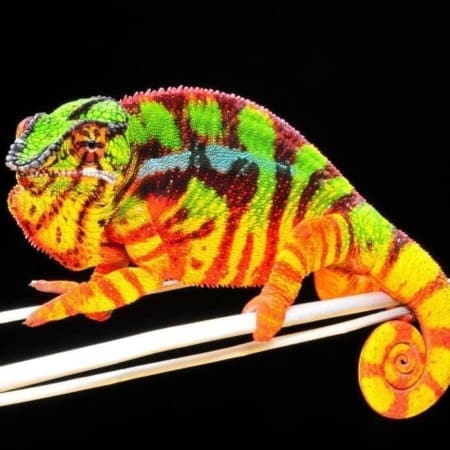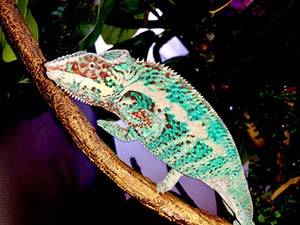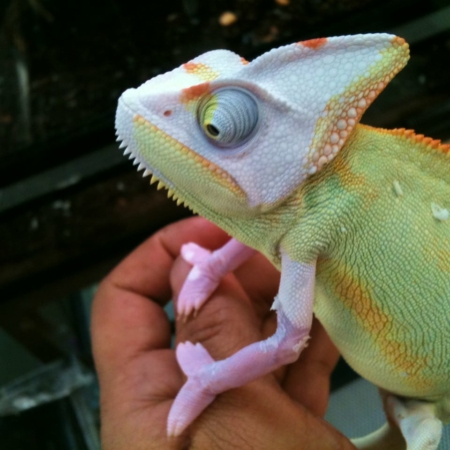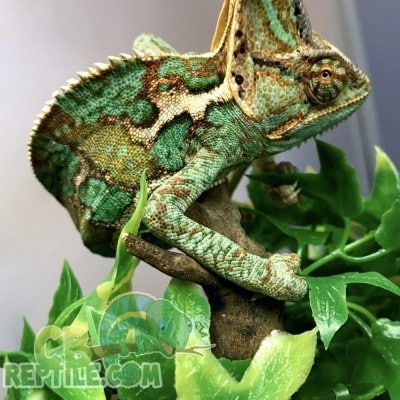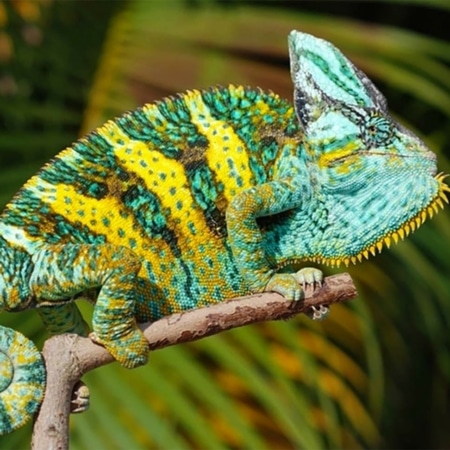Panther Chameleon Lifespan
Male panther chameleons can grow up to 7.9 inches in length, panther chameleons are normally 6.7 inches long. Females are smaller, at about half the size. In a form of sexual dimorphism, males are more vibrantly colored than the females
Before purchasing your new baby panther chameleon for sale online, please find a reputable CAPTIVE BRED panther chameleon for sale, from an experienced Panther Chameleon Breeder (like us!)
Below you will find detailed information on panther chameleon care provided by our biologist including the following:
- panther chameleon breeders
- panther chameleon enclosure
- panther chameleon care sheet
- panther chameleon lighting
- panther chameleon habitat for sale
- panther chameleons for sale
- panther chameleon habitat
- panther chameleon water
- panther chameleon handling
- panther chameleon caging
- panther chameleon substrate
- baby panther chameleon
- How to pick up a panther chameleon
- panther chameleon lifespan
- panther chameleon substrate
- panther chameleon temperature
- panther chameleon morphs
- panther chameleon pictures
- chameleon
- chameleon for sale
- Species: Furcifer pardalis
Life Span: 4-8 years
Adult Size: Female: 10inch (including tail) Male: 12-17inch (including tail)
Natural Distribution: Madagascar and outlying islands (hereby known as panther chameleon locales)
Temperature Requirements: Background: 75-85 F with a Basking spot of 92-99 F
Habitat Type: Open forest
Adult Enclosure Size: 24in x 24in x 48in for an individual. Should not be housed together.
Panther chameleons (Furcifer pardalis) are a one of the larger chameleon species originating from Madagascar. They occur over large areas of this micro continent and as such can be found living in a wide variety of habitats. This species is large and visually impressive, when people think of a stereotypical chameleon it is often the panther chameleon that they have in mind.
Their large geographic range and highly variable colouration has led to them often being sold with locality specific data attached e.g ‘Ambanja panther chameleon’ this simply refers to one that has the colour scheme originating from this area of Madagascar. They may also be referred to as being Blue Bar or Red Bar when referring to some localities, again this refers to their colouration with individuals having prominent Red or Blue bars down their flanks.
It is worth highlighting at this point that it really is only the males that gain the spectacular colors and the locality specific color schemes. Females from all localities lack most, if not all, traces of markings and are usually pale pastel shades of yellows, oranges, reds, grays, greens and blues. It is nearly impossible to tell the difference between specific localities of most female panther chameleons by visual inspection only.
Panther Chameleon Habitat Panther Chameleon Caging
Dependent upon the age of your panther chameleon their captive requirements vary with age. There is an exaggerated adult size difference between males and females, males being larger. Due to this males require larger housing when adult. Although they can be housed in a number of ways successfully we tend to opt for heavily planted mesh or part mesh and part glass enclosures to ensure adequate ventilation.
It is particularly important to avoid stale air when keeping chameleons as this can lead to a number of health problems. Some people may find it difficult to maintain the humidity in all mesh enclosures but we find that as long as there are plenty of live plants and frequent misting (either manual or automated) these are the best enclosures for the purpose.
We tend to use glass enclosures with mesh tops for rearing babies and juveniles as the smaller enclosure size tends to reduce the chance of poor airflow and good hydration and humidity levels are particularly important for young chameleons. Melamine and/or glass enclosures can be used but it must be ensured that there is ample ventilation which may mean installing additional air vents into ‘off the shelf’ melamine vivariums.
Adult Housing: We recommend Reptibreeze panther Chameleon cages found here.
Min 30 x 18 x 36 mesh or part mesh part glass (Male)
Min 18 x 18 x 36 mesh or part mesh part glass (Female)
Baby/Juvenille Housing:
18 x 18 x 36 mesh or part glass part mesh
Furnishings:
Orchid bark substrate
Jungle vines and lianas (thin braches)
Cork branches
Fake plants (3-5 in number)
Live plants (2-3 in number) Ficus/weeping fig or umbrella plants are ideal
UVB Lamp (6% UVB minimum)
Basking lamp (50-100w dependent upon enclosure size)
Other Kit:
Spray bottle
Komdo Calci Dust
Neutrobal calcium and multivitamin supplement
Digital thermometer/hygrometer combo meter
Tank Design:
It sounds odd that we should advise how to furnish the enclosure as often this is a personal preference but there are a few tips and tricks to ensure the young chameleons can get the best out of their enclosure. We suggest that you place live plants throughout and that these plants should touch the mesh lid to enable a route from the bottom of the enclosure right up to the mesh (young panther chameleons will often hang upside down on the underside of the mesh so allowing them to freely climb onto and off the mesh is advisable).
There should also be a vine positioned to act as a basking site under the basking bulb.
Plenty of branches and vines are essential as are live plants, adults kept in enclosures without adequate climbing branches will often attempt to replicate the juvenile activity of climbing the mesh itself. This can be an issue as the adult claws do not normally fit in the mesh (they shouldn’t if you are using a fine enough mesh to stop live food escaping, e.g Zoo med reptibreeze enclosures or Komodo chameleon enclosures) this can lead both to them falling and also to loss of claws either through abrasion and/or pulling them out when stuck.
Neither is a good option. It is also essential to provide a full canopy of plants (mostly live but some plastic/silk can be used) a chameleon that feels insecure (due to lack of foliage) will often hide considerably more and display less than one whose enclosure is almost full of plants. The more places to hide and feel secure the less they feel restricted to using them.
Additional Notes on housing:
The positioning of the enclosure both for adults and young can have an impact both on the behaviour and health of your panther chameleon. Considering the mesh enclosures we advise for adults it is essential that they are kept out of a draught, not only can this lead to low humidity levels and associated health problems but this can inadvertently lead to your chameleon developing respiratory infections
Numbers:
Panther chameleons should always be housed individually as they are not social creatures. A visual barrier should also be provided between males, and between males and females to avoid constant display behaviour and therefore stress.
Panther Chameleon Lighting Panther Chameleon Heating Panther Chameleon UVB Light Panther Chameleon Temperature
Panther chameleons are ‘sun worshippers’ and will actively bask under high level UVB lights and high Lux lighting (high intensity visible light). We provide young and adult panther chameleons with10-12%UVB Flow tubes resting on top of the mesh of their enclosure, we do not suggest mounting the UVB tube inside the enclosure as young panther chameleons will attempt to get as close as possible to the light sources.
We have heard reports of young panther chameleons injuring themselves by coming into contact with UV flow tubes for prolonged periods of time so it’s best to avoid this possibility. The UV light should be turned on for between 10-12 hours a day and turned off at night. Example bulbs would be an Arcadia 6% core range bulb, 10% Euro range bulb, an Arcadia 12% T5 UV bulb or an Arcadia D3 UV Flood Unit.
For a basking site we suggest the use of 50w halogen bulbs for young panther chameleon care in smaller enclosures and a 100w for the adult anther chameleon enclosures. Halogen bulbs have higher Lux (visable light) rating then ordinary incandescent bulbs but if halogens are not available any good quality reptile bulb containing Neodymium will provide a bright white basking light. This basking site needs to be set to one end of the enclosure so the panther chameleon can move away from it freely. The aim is to create a high intensity basking spot with a relatively low ambient temperature.
Temperature Preferences in Captivity:
Panther chameleons prefer to actively bask in order to thermo regulate (control their body temperature). An ambient of 24-26C with a localised basking spot of 30+C is ideal. The basking lamp should be placed over one corner of the enclosure to allow room for the chameleon to move away from the heat. A branch or vine should be placed approximately 6-12 inches below the basking lamp to create a basking area. At night time the basking light should be turned off to allow a temperature drop to around 20-22C.
Daily Maintenance:
Regular misting of the live plants in the tank is essential to keep your chameleon hydrated and to boost the humidity levels. Chameleons will rarely (if ever) drink from standing water in a water bowl so spraying the live plants will cause water droplets to form on the leaves which your chameleon will then drink . This should be done 2-3 times a day. Try not to spray chameleons directly. Allow the tank to dry out in between sprays to provide a humidity cycle with highs and lows of humidity. Your chameleon does not need to be at high humidity constantly as this can cause skin infections.
We don’t use waterfalls in with our chameleons as we have found only a small percentage will use them and they can harbour harmful bacteria, instead we prefer the multiple misting route of hydration. Over time many chameleons learn to drink directly from the spray bottle when you are misting them. Other tasks to be undertaken on a daily basis include spot cleaning (remove any visible waste and dead live-food) and provide with fresh food.
Panther Chameleon Diet Panther Chameleon Feeding
Baby panther chameleons need permanent access to food and will eat an astonishing amount. Fresh hatchling chameleons up to about 5-6 weeks old will take fruit flies and micro crickets (mostly just fruit flies). We tend to leave a culture in the enclosure with a hole in the lid to allow a small trickle to escape into the enclosure (a permanent food source). We then add supplemented fruit flies once a day (approximately 30 per baby chameleon, as many will escape out of the mesh and it is vital to get some supplementation into them).
With the crickets we ‘cup feed’ them when they are young, this involves putting supplemented crickets into a small ‘cup’ (quite often we use a cut down cricket tub or a wax worm pot). This concentrates the crickets into a small area. We then wedge the cup up in amongst the live plants to enable the chameleons to feed naturally up in the foliage rather than having to come down to the floor to feed. As they get older we begin feeding them locusts as well as they are a more suitable food source once the chameleon is adult. It is not until the chameleons are at least 6 months old that we stop cup feeding them completely.
Live food (crickets and locusts) come in a variety of sizes and you want to increase the size of the prey item as your panther chameleon grows. As an adult (approximately 18 months of age) the feeding regime changes to only feeding approximately 6 large locusts every other day. Adult panther chameleons should not be over fed; Gout and/or liver problems can become a problem if they are fed high fat diets (coupled with poor hydration) so we don’t tend to feed mealworms/wax worms/silkworms or any other grubs to adults.
Additionally we rarely if ever use cockroaches as a feeder for adult panther chameleon care, many successful panther chameleon breeders feed large quantities of ‘roaches’ to their adults but due to the high fat and protein content of these feeder insects we tend not to (please read the Global Geckos Article on the nutritional content of feeder insects to find out more). Mostly we stick to Locusts for about 80% of their diet and crickets for about 20% of their diet.
Once a full adult (2 years old +) male panther chameleons don’t eat a huge amount and often 10-15 locusts per week is adequate.
Supplementation:
Although we are firm believers in using calcium and multivitamin supplements, in particular Neutrobal®, panther chameleons can suffer from Hypervitaminosis (an overdose of vitamins, usually relating to dietary vitamin D3, an additive in Neutrobal®). Because of this risk we restrict panther chameleons intake of multivitamins and dietary vitamin D3. Therefore we use pure calcium carbonate (e.gKomodo cricket dust) on their food 3-5 times a week and only supplement using a very light dusting of Neutrobal® once every 7-14 feeds.
Activity Pattern:
Panther chameleons are diurnal, this means they are active during the day time and asleep at night. Young panther chameleons will often roam around their cage during the day while adults can be comparatively lazy often choosing to find a comfortable perch and spend large parts of the day resting and simply observing what’s going on around them. Panther chameleons should spend the majority of their time off the floor so it may be a sign of a problem if your chameleon is spending a lot of its time sat on the floor.
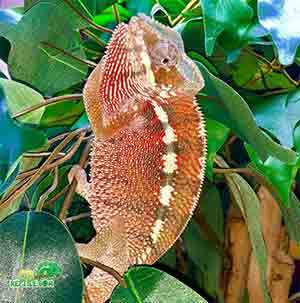
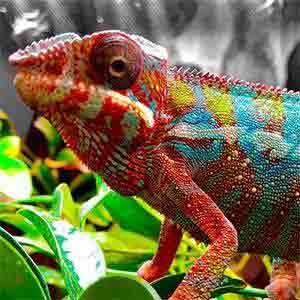
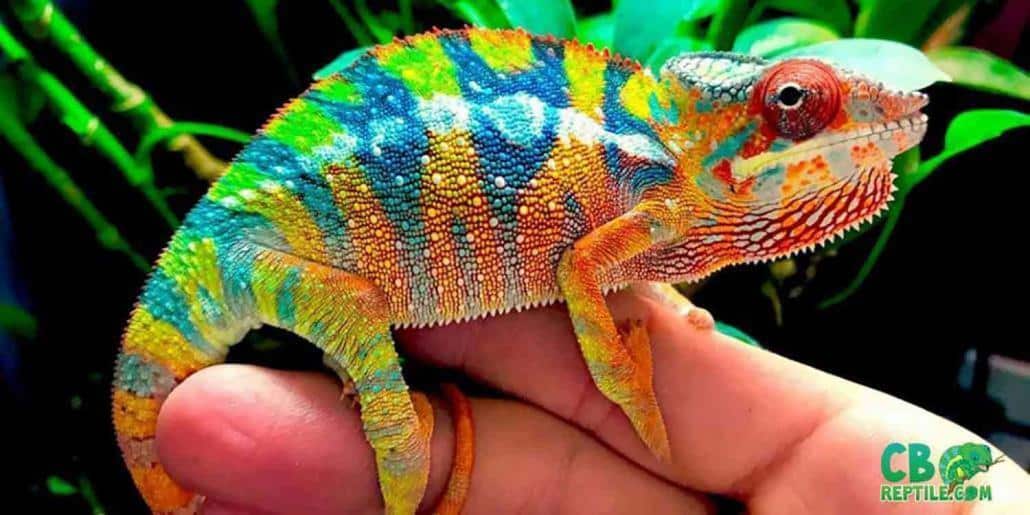
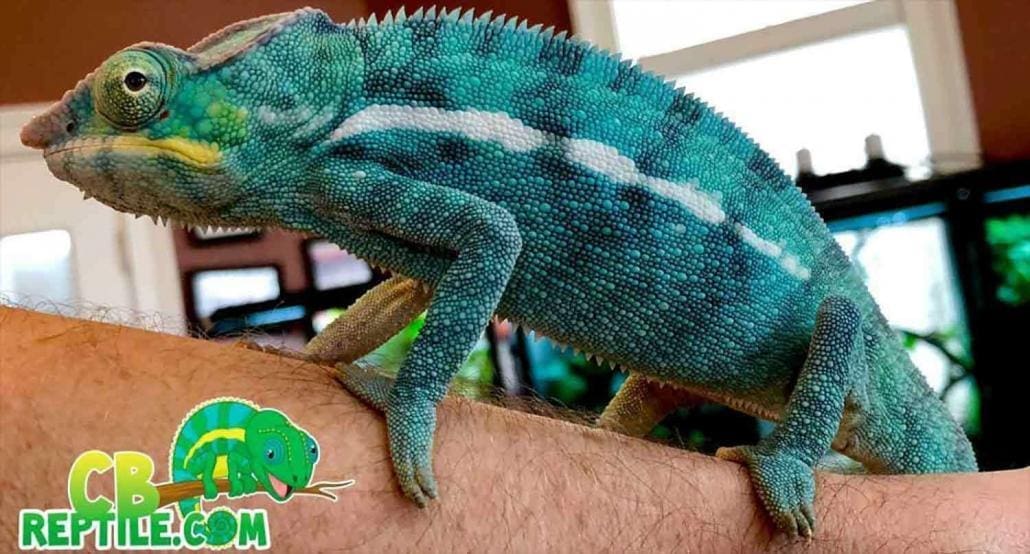
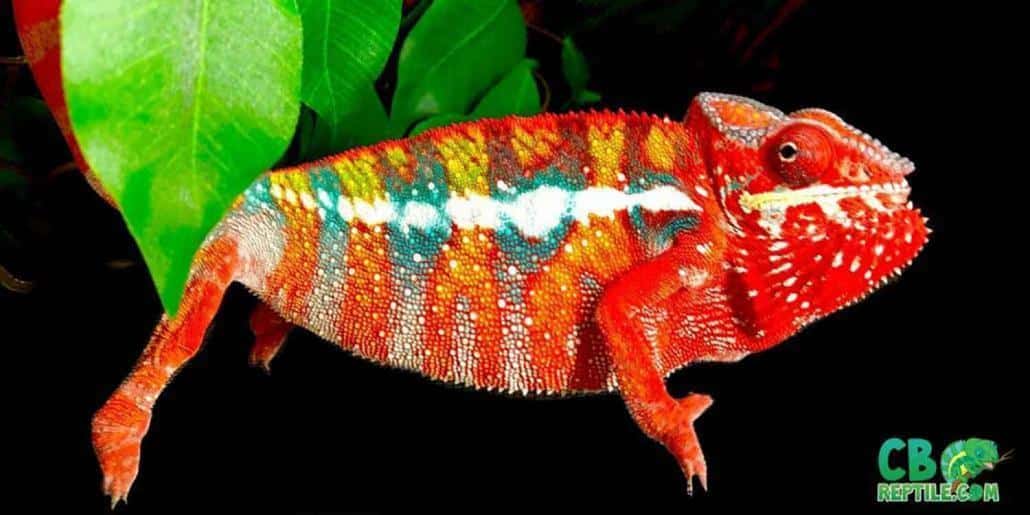
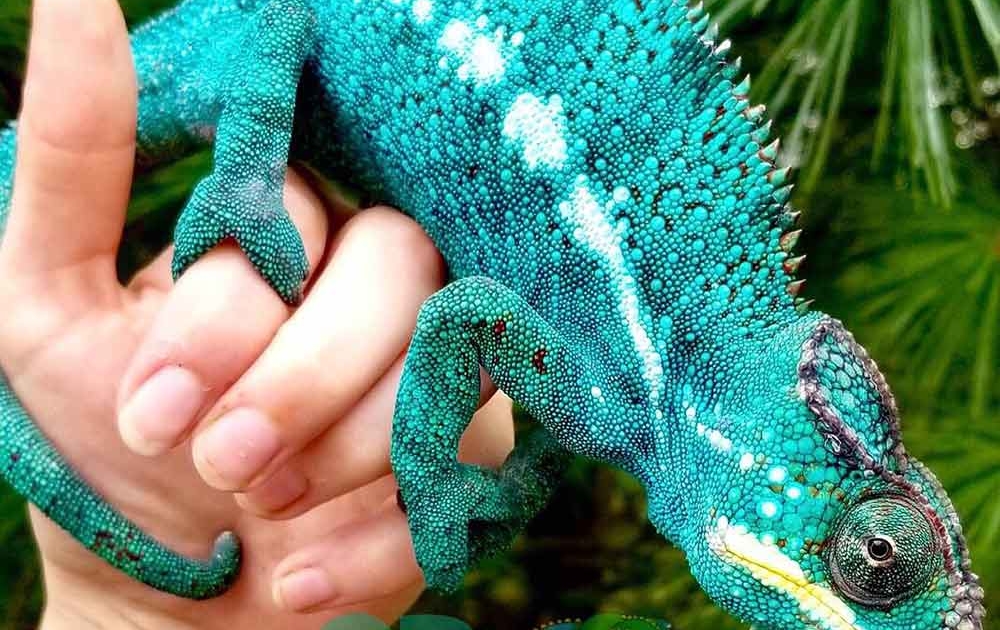

-
 Rated 5.00 out of 5
Rated 5.00 out of 5Designer Cross Panther Chameleon
$429.00 – $749.00 Sale!Select options This product has multiple variants. The options may be chosen on the product page -

Nosy Mitsio Panther Chameleon for sale
$329.00 – $699.00 Sale!Select options This product has multiple variants. The options may be chosen on the product page -
 Rated 5.00 out of 5
Rated 5.00 out of 5Ambanja Panther Chameleon
$389.00 – $689.00 Sale!Select options This product has multiple variants. The options may be chosen on the product page -

Sambava panther chameleon for sale
$399.00 – $679.00 Sale!Select options This product has multiple variants. The options may be chosen on the product page -

Cap Est Panther Chameleon for sale
$379.00 – $679.00 Sale!Select options This product has multiple variants. The options may be chosen on the product page -
 Rated 5.00 out of 5
Rated 5.00 out of 5Ambilobe Panther Chameleon
$369.95 – $679.00 Sale!Select options This product has multiple variants. The options may be chosen on the product page -

Baby Panther Chameleon for sale
$349.95 – $599.99 Sale!Select options This product has multiple variants. The options may be chosen on the product page -
 Rated 5.00 out of 5
Rated 5.00 out of 5Yellow Body Blue Bar Ambilobe Panther Chameleon
$359.00 – $599.00 Sale!Select options This product has multiple variants. The options may be chosen on the product page -

Red Body Blue Bar Ambilobe Panther Chameleon
$369.95 – $599.00 Sale!Select options This product has multiple variants. The options may be chosen on the product page -
 Rated 5.00 out of 5
Rated 5.00 out of 5Nosy Be Panther Chameleon
$349.00 – $569.00 Sale!Select options This product has multiple variants. The options may be chosen on the product page -

Tamatave Panther Chameleon for sale
$289.00 – $529.00 Sale!Select options This product has multiple variants. The options may be chosen on the product page -

High White Pied Veiled Chameleons
$249.00 – $499.00 Sale!Select options This product has multiple variants. The options may be chosen on the product page -

Sambava Panther Chameleon
$299.00 – $499.00 Sale!Select options This product has multiple variants. The options may be chosen on the product page -
 Rated 5.00 out of 5
Rated 5.00 out of 5Nosy Faly Panther Chameleon
$339.00 – $499.00 Sale!Select options This product has multiple variants. The options may be chosen on the product page -

Diego Suarez Panther Chameleon
$269.00 – $479.00 Sale!Select options This product has multiple variants. The options may be chosen on the product page -

Translucent Veiled Chameleon
$179.00 – $379.00 Sale!Select options This product has multiple variants. The options may be chosen on the product page -
 Rated 5.00 out of 5
Rated 5.00 out of 5Veiled Chameleon
$129.00 – $349.00 Sale!Select options This product has multiple variants. The options may be chosen on the product page -
 Rated 5.00 out of 5
Rated 5.00 out of 5Designer Veiled Chameleon
$189.95 – $289.95 Sale!Select options This product has multiple variants. The options may be chosen on the product page

